Mechanical Response and Deterioration Mechanisms in Freeze–Thaw Environments for Crushed Stone Stabilized with Industrial Solid Waste
Abstract
1. Introduction
2. Test Methods and Preparation
2.1. Micro Test
2.1.1. Scanning Electron Microscope
2.1.2. Mercury Intrusion Porosimetry
2.1.3. X-ray Fluorescence Analysis
2.2. Freeze–Thaw Cycle Test
2.3. Mechanical Test
2.3.1. Unconfined Compression Strength
2.3.2. Indirect Tensile Strength
2.3.3. Compressive Rebound Modulus
2.4. Raw Material
2.4.1. Gravel
2.4.2. Mineral Powder
2.4.3. Wet Calcium Carbide Slag
2.4.4. Fly Ash
2.4.5. NaOH
2.4.6. Cement
2.5. Mix Design
2.5.1. Sieve Test
2.5.2. Unconfined Compressive Strength Test and Compaction Test
2.6. Specimen Preparation
3. Result Analysis
3.1. Freeze–Thaw Cycle Test
3.2. Scanning Electron Microscope
3.3. Mercury Intrusion Porosimetry
3.3.1. Results of Mercury Intrusion Porosimetry
3.3.2. Grey Relation Analysis of Mixture Performance Index and MIP Results under Freeze–Thaw Cycle Conditions
4. Discussion
5. Conclusions
- (1)
- After adding 20% geopolymer into the mixture, the UCS and ITS are better than those of the mixture without a geopolymer, whether before or after the freeze–thaw cycle. This shows that that adding an appropriate amount of geopolymer has a positive influence on the UCS and ITS of the mixture.
- (2)
- When the amount of geopolymer is too large, the strength of the mixture will decrease. After freezing and thawing cycles, the loss of UCS and ITS is also expressively greater than that of the mixture mixed with 0% and 20% geopolymer. This shows that the amount of geopolymer must be appropriate to maintain the strength of the mixture.
- (3)
- According to the comparative analysis of the results of the mechanical properties test and MIP after freezing and thawing cycle, it is indicated that the mixture with 20% geopolymer is superior to the mixture without and with 40% geopolymer in terms of frost resistance. This shows that an appropriate geopolymer content can improve the freezing resistance of the mixture.
- (4)
- The results of grey relation analysis indicate that the loss of UCS in the mixture after freezing and thawing cycles is mainly affected by the increase in total porosity, while the loss of ITS is mainly related to the increase in harmful pores and total porosity. It is worth noting that the CRM is basically not affected by these three types of pore sizes. This shows that when evaluating the performance of the mixture, it is necessary to consider the influence of different factors on the strength indicators, such as UCS, CRM and ITS.
Author Contributions
Funding
Institutional Review Board Statement
Informed Consent Statement
Data Availability Statement
Conflicts of Interest
References
- Kwan, C.L. The Inner Mongolia Autonomous Region: A major role in China’s renewable energy future. Util. Policy 2010, 18, 46–52. [Google Scholar] [CrossRef]
- Meskhi, B.; Beskopylny, A.N.; Stel’makh, S.A.; Shcherban’, E.M.; Mailyan, L.R.; Shilov, A.A.; El’shaeva, D.; Shilova, K.; Karalar, M.; Aksoylu, C.; et al. Analytical review of geopolymer concrete: Retrospective and current issues. Materials 2023, 16, 3792. [Google Scholar] [CrossRef]
- Zhao, C.; Li, J.; Zhu, Z.; Guo, Q.; Wu, X.; Wang, Z.; Zhao, R. Research on the Carbonation Resistance and Carbonation Depth Prediction Model of Fly Ash-and Slag-Based Geopolymer Concrete. KSCE J. Civ. Eng. 2024, 28, 2802–2817. [Google Scholar] [CrossRef]
- Yang, G.; Li, C.; Xie, W.; Yue, Y.; Kong, C.; Li, X. Effect of carbide slag and steel slag as alkali activators on the key properties of carbide slag-steel slag-slag-phosphogypsum composite cementitious materials. Front. Mater. 2024, 11, 1353004. [Google Scholar] [CrossRef]
- Subramanian, S.; Davis, P.R.; Thomas, B.S. Sustainable engineered geopolymer composites: A study on the potential of fly ash, BOF slag, and iron ore tailings. Environ. Eng. Res. 2024, 29, 230540. [Google Scholar] [CrossRef]
- Gao, Y.; Zhu, Z.; Zhu, J.; Hu, X. Study on the mechanical properties and water stability of steel slag-fly ash geopolymer for base Stabilisation. Int. J. Pavement Eng. 2024, 25, 2308168. [Google Scholar] [CrossRef]
- Ghosh, A.; Ransinchung, R.N.G.D. Performance evaluation of fly ash and red mud as geopolymer concrete precursors for rigid pavement application. Int. J. Pavement Res. Technol. 2024, 17, 680–692. [Google Scholar] [CrossRef]
- Al-Dossary, A.A.; Awed, A.M.; Gabr, A.R.; Fattah, M.Y.; El-Badawy, S.M. Performance enhancement of road base material using calcium carbide residue and sulfonic acid dilution as a geopolymer stabilizer. Constr. Build. Mater. 2023, 364, 129959. [Google Scholar] [CrossRef]
- Lu, X.; Tian, Y.; Jiskani, I.M.; Zhou, W.; Zhao, B.; Ding, X.; Ao, Z. Innovate geopolymer synthesis for green mine road construction: Analysis of efflorescence behavior and strength analysis. Constr. Build. Mater. 2023, 401, 132963. [Google Scholar] [CrossRef]
- Sun, Y.; Yang, Y.; Niu, X.; Yang, J.; Deng, K.; Song, S.; Shi, X.; Wen, Z.; Wang, Y. Pavement Performance of Fine-Grained Soil Stabilized by Fly Ash and Granulated Blast Furnace Slag-Based Geopolymer as Road Base Course Material. J. Mater. Civ. Eng. 2024, 36, 04024167. [Google Scholar] [CrossRef]
- Ji, X.; Chen, B.; Dong, X.; Lu, H.; Zhang, X.; He, S.; Wu, T. Mechanical and environmental properties of geopolymer-stabilized domestic waste incineration slag in an asphalt pavement base. J. Road Eng. 2023, 3, 218–228. [Google Scholar] [CrossRef]
- Tabyang, W.; Kuasakul, T.; Sookmanee, P.; Laksanakit, C.; Chusilp, N.; Bamrungphon, Y.; Suksiripattanapong, C. Use of a rubber wood fly ash-based geopolymer for stabilizing marginal lateritic soil as green subbase materials. Clean Technol. Environ. Policy 2024, 26, 2059–2073. [Google Scholar] [CrossRef]
- Alakara, E.H.; Nacar, S.; Sevim, O.; Korkmaz, S.; Demir, I. Determination of compressive strength of perlite-containing slag-based geopolymers and its prediction using artificial neural network and regression-based methods. Constr. Build. Mater. 2022, 359, 129518. [Google Scholar] [CrossRef]
- Feng, B.; Liu, J.; Chen, Y.; Tan, X.; Zhang, M.; Sun, Z. Properties and microstructure of self-waterproof metakaolin geopolymer with silane coupling agents. Constr. Build. Mater. 2022, 342, 128045. [Google Scholar] [CrossRef]
- Singh, S.; Kumar, A.; Sitharam, T.G. Mechanical, Microstructural, and Durability Properties of Soil Stabilized with Alkali-Activated Jarofix for Road Applications. J. Hazard. Toxic Radioact. Waste 2023, 27, 04023020. [Google Scholar] [CrossRef]
- Anburuvel, A.; Sathiparan, N.; Dhananjaya GM, A.; Anuruththan, A. Characteristic evaluation of geopolymer based lateritic soil stabilization enriched with eggshell ash and rice husk ash for road construction: An experimental investigation. Constr. Build. Mater. 2023, 387, 131659. [Google Scholar] [CrossRef]
- Cao, R.; Fang, Z.; Shang, Y. Production of a New Base Material for Load-Bearing Water-Storing Road. J. Mater. Civ. Eng. 2022, 34, 04022144. [Google Scholar] [CrossRef]
- Turkane, S.D.; Chouksey, S.K. Design of low volume road pavement of stabilized low plastic soil using fly ash geopolymer. Mater. Today Proc. 2022, 65, 1154–1160. [Google Scholar] [CrossRef]
- Pang, Y.; Zhu, X.; Yang, M.; Yu, J. Tailoring rheological–strength–ductility properties of self-cleaning geopolymer composites with asphalt emulsion. Constr. Build. Mater. 2021, 308, 124997. [Google Scholar] [CrossRef]
- Zhang, Y.; Gong, H.; Jiang, X.; Lv, X.; Xiao, R.; Huang, B. Environmental impact assessment of pavement road bases with reuse and recycling strategies: A comparative study on geopolymer stabilized macadam and conventional alternatives. Transp. Res. Part D 2021, 93, 102749. [Google Scholar] [CrossRef]
- Qin, L.; Nie, Q.; Zhang, H.; Jia, X.; Zhang, C. Laboratory experimental study on red mud geopolymer used as road subgrade materials. E3S Web Conf. 2021, 261, 02043. [Google Scholar] [CrossRef]
- Lu, X.; Tu, L.; Tian, Y.; Zhou, W.; Zhao, X.; Yang, Y. Experimental Study of the Freeze–Thaw Damage of Alpine Surface Coal Mine Roads Based on Geopolymer Materials. Water 2023, 15, 3903. [Google Scholar] [CrossRef]
- Zhao, Q.; Liu, J.; Wu, L.; Lu, X.; Li, H.; Hu, W.; Zhang, Y.; Kong, X.; Jing, S. Frost Resistance and Shrinkage Characteristics of Soil Stabilized by Carbide Slag and Coal Gangue Powder. Sustainability 2023, 15, 2249. [Google Scholar] [CrossRef]
- Hao, Y. Experimental Study on Durability of Red Mud-Based Cementitious Material Stabilized Crushed Stone. Master’s Thesis, Shandong University, Jinan, China, 2024. [Google Scholar]
- Ji, X.; Mou, K.; Zhang, T.; Dong, X. Durability of geopolymer stabilized domestic waste incineration slag blending macadam in pavement base. Front. Mater. 2023, 10, 1334547. [Google Scholar] [CrossRef]
- JTG E42—2005; Test Methods of Aggregate for Highway Engineering. Ministry of Transport of the People’s Republic of China: Beijing, China, 2005; pp. 7–45.
- JTG E40—2007; Test Methods of Soils for Highway Engineering. Ministry of Transport of the People’s Republic of China: Beijing, China, 2007; pp. 398–407.
- JTG E41—2005; Test Methods of Rock for Highway Engineering. Ministry of Transport of the People’s Republic of China: Beijing, China, 2005; pp. 5–18.
- JTG/T F20—2015; Technical Guidelines for Construction of Highway Roadbases. Ministry of Transport of the People’s Republic of China: Beijing, China, 2015; pp. 4–27.
- JTG E51—2009; Test Methods of Materials Stabilized with Inorganic Binders for Highway Engineering. Ministry of Transport of the People’s Republic of China: Beijing, China, 2009; pp. 67–113.
- Wichowski, P.; Kalenik, M.; Rutkowska, G.; Malarski, M.; Czajkowska, J.; Franus, W. Characteristics of products made in the process solidification and stabilization of fly ash from combustion of sewage sludge. Cem. Wapno Betonm Cem. Lime Concr. 2024, 28, 389–408. [Google Scholar]
- Li, Y.-C.; Min, X.-B.; Ke, Y.; Chai, L.-Y.; Shi, M.-Q.; Tang, C.-J.; Wang, Q.-W.; Liang, Y.-J.; Lei, J.; Liu, D.-G. Utilization of red mud and Pb/Zn smelter waste for the synthesis of a red mud-based cementitious material. J. Hazard. Mater. 2018, 344, 343–349. [Google Scholar] [CrossRef]
- Tang, S.B.; Wang, S.Y.; Ma, T.H.; Tang, C.A.; Bao, C.Y.; Huang, X.; Zhang, H. Numerical study of shrinkage cracking in concrete and concrete repair systems. Int. J. Fract. 2016, 199, 229–244. [Google Scholar] [CrossRef]
- Wu, Z.W. Discussion on the recent development direction of concrete science and technology. J. Chin. Ceram. Soc. 1979, 3, 262–270. [Google Scholar]

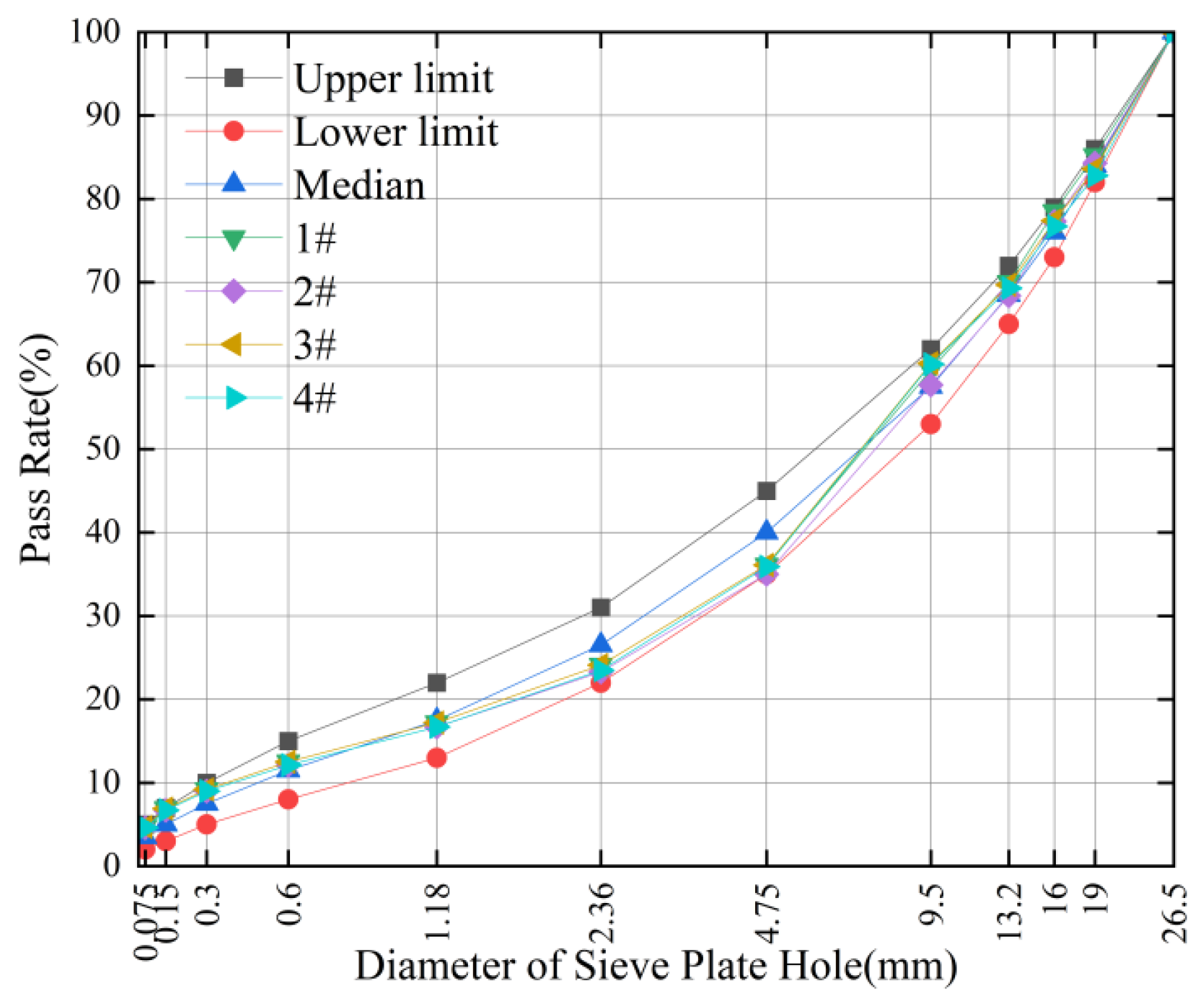

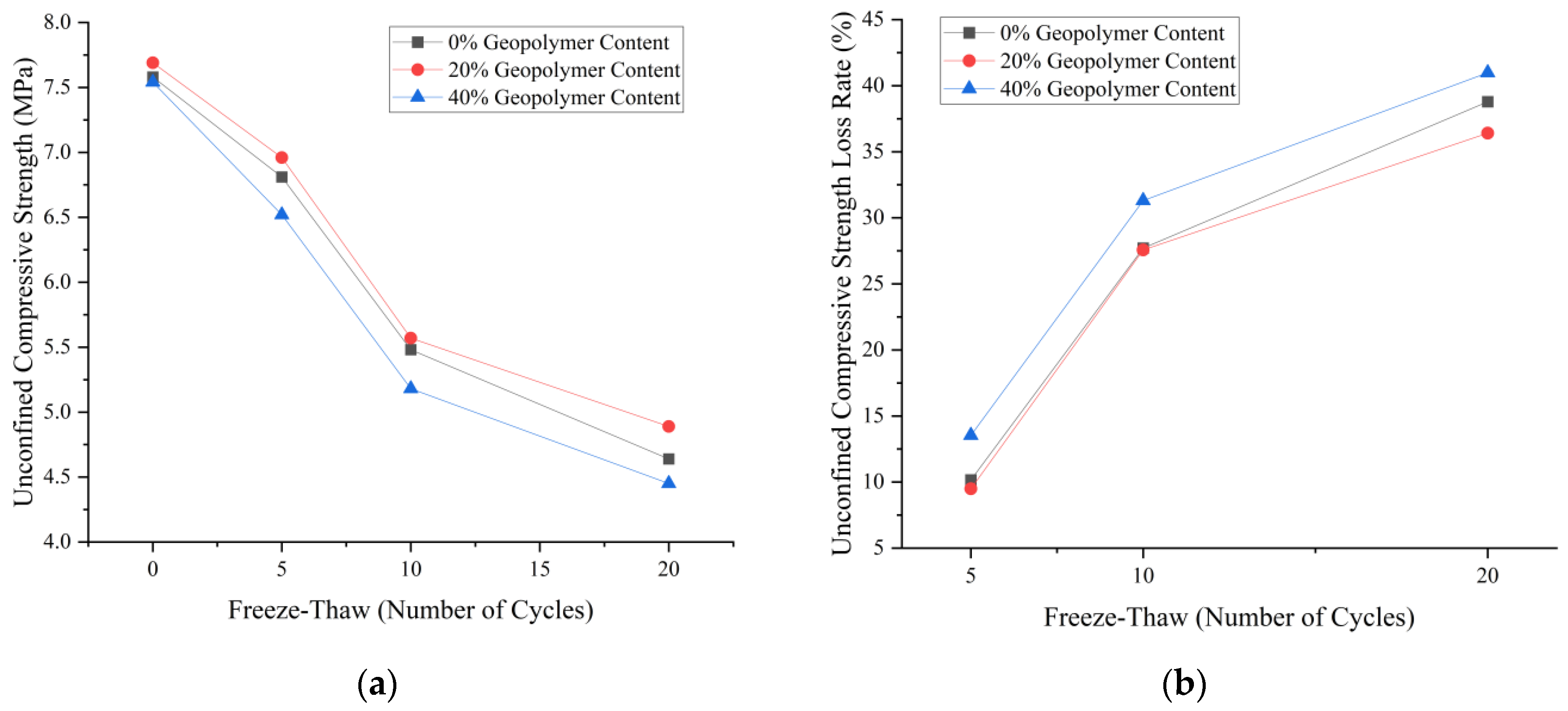
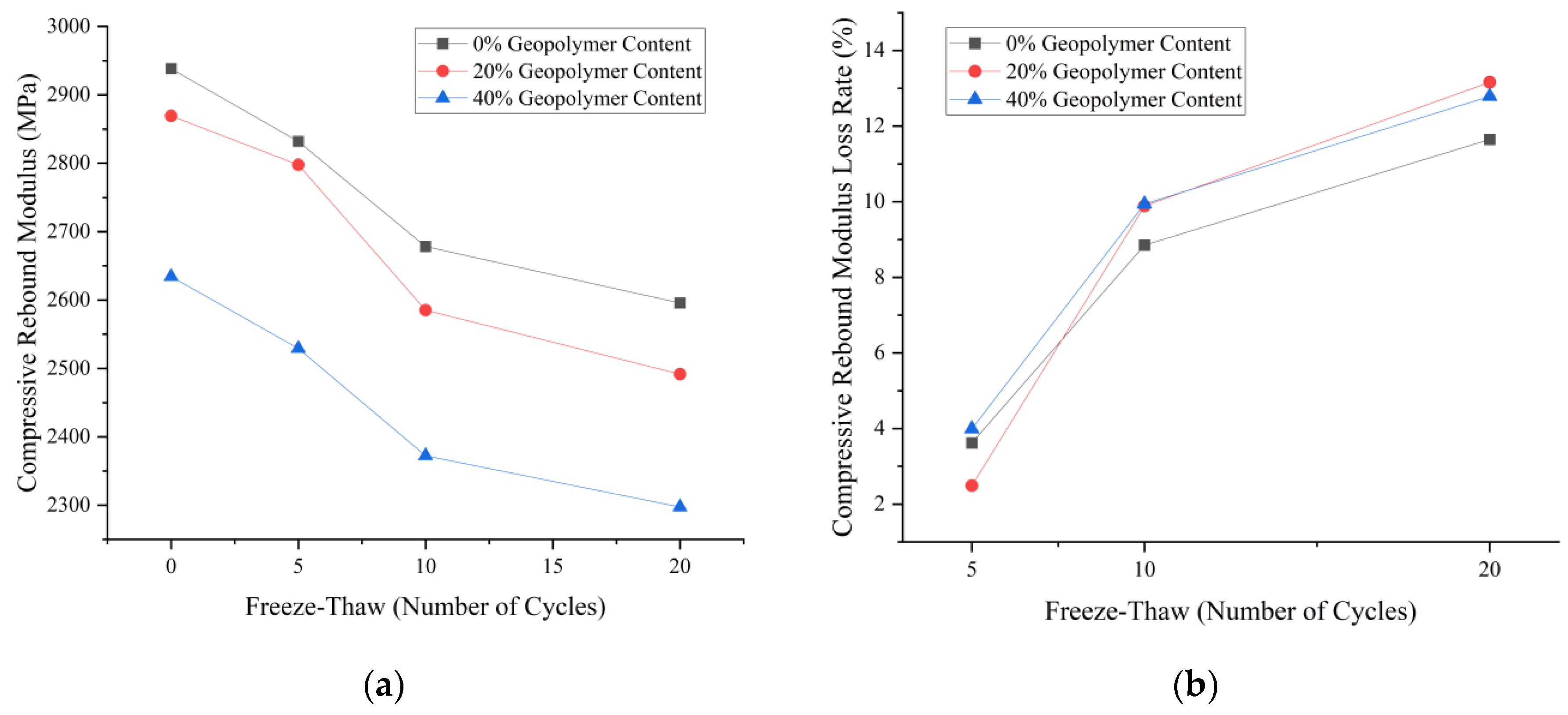

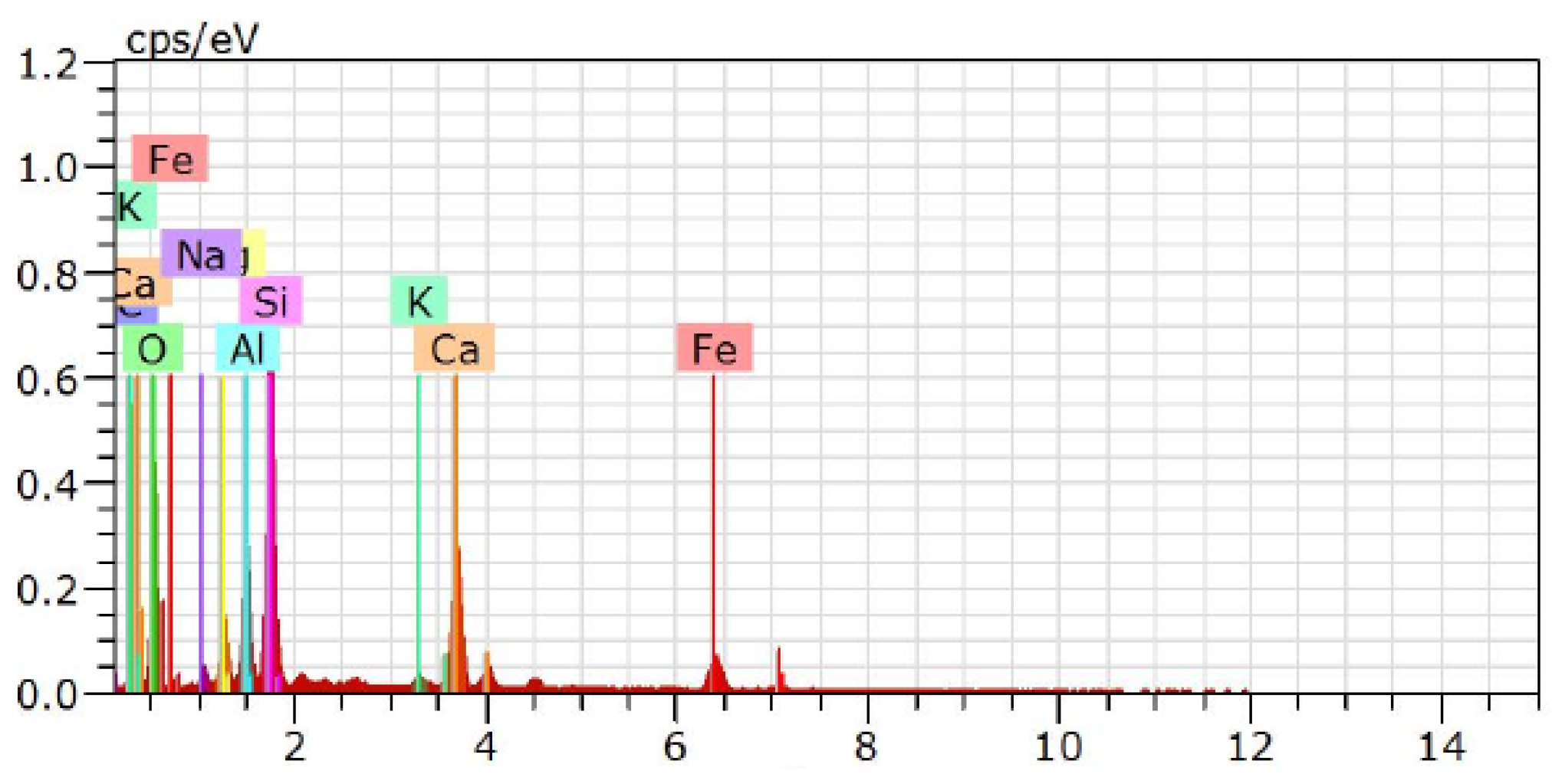
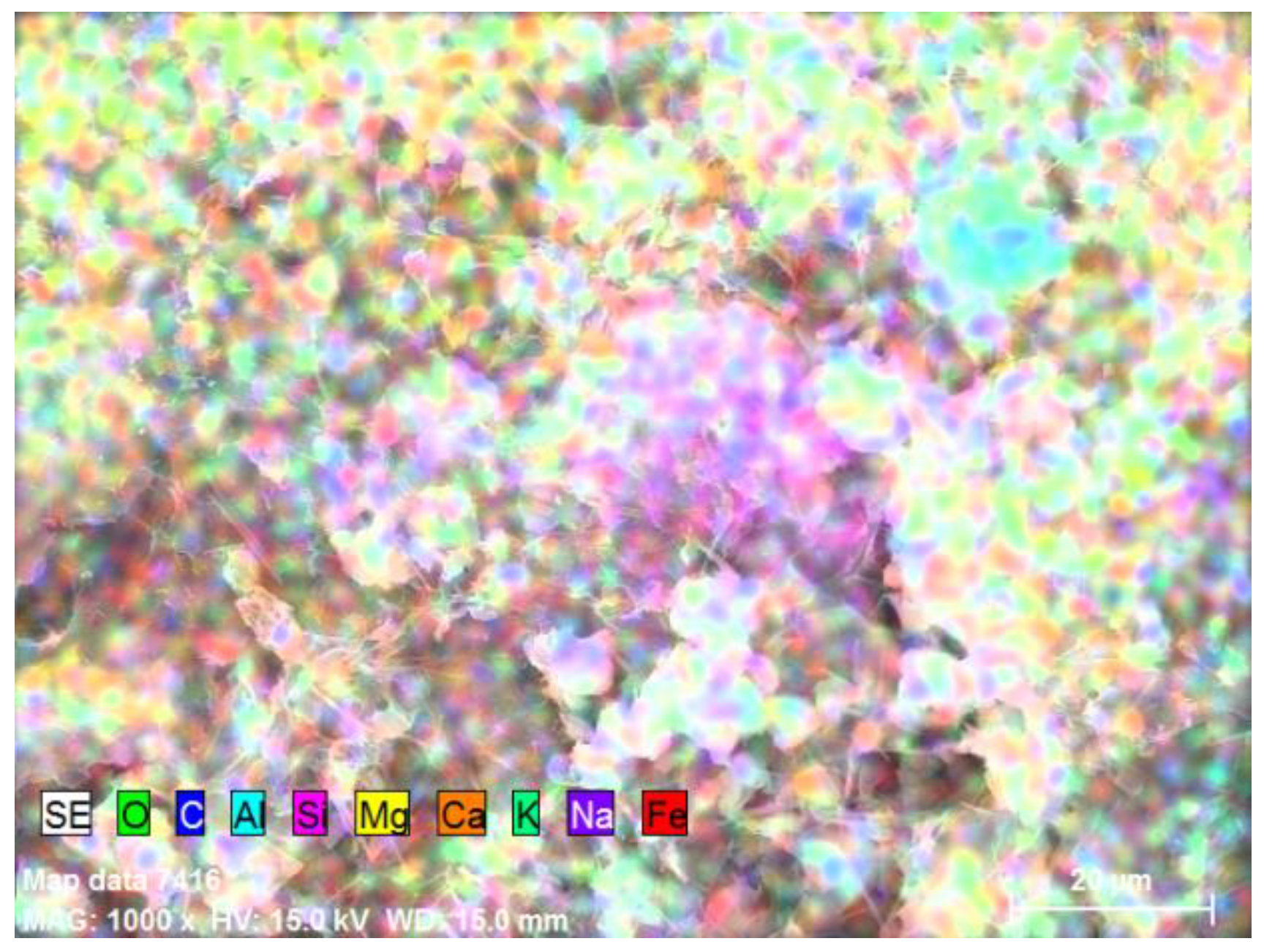


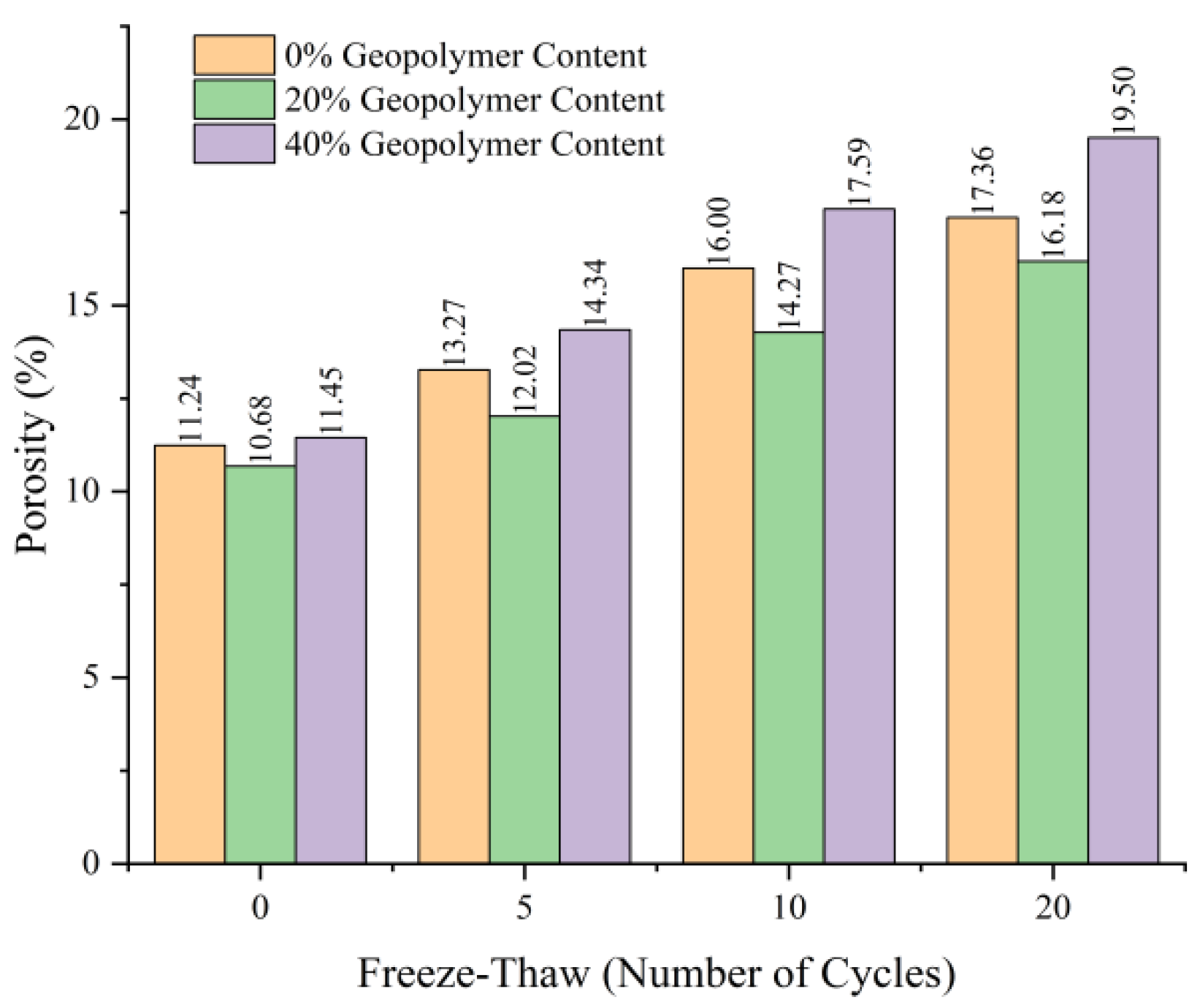
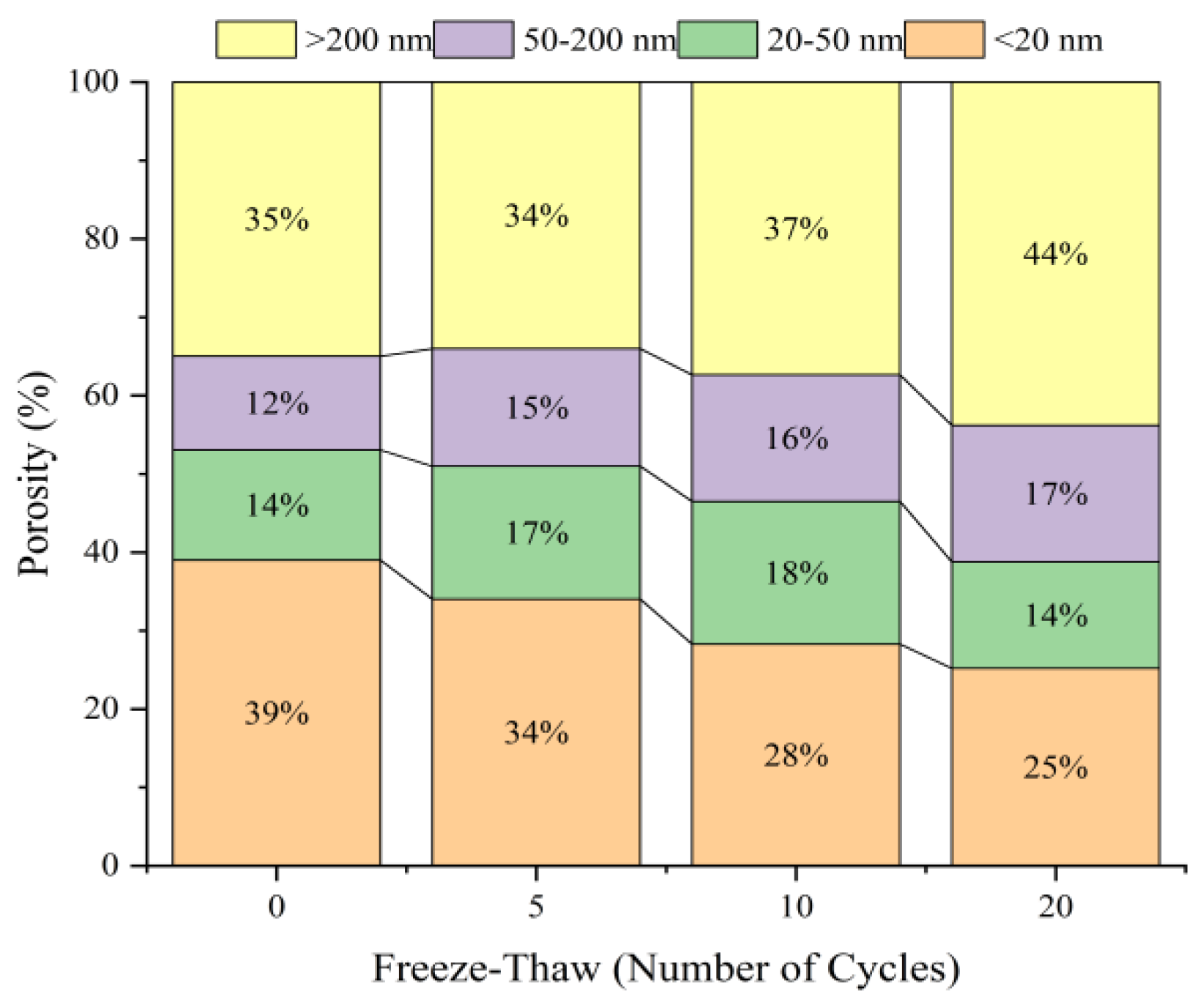
| Grain Size (mm) | Apparent Density (g·cm−3) | Needle-like Content (%) | Absorption Rate (%) | Crush Value (%) |
|---|---|---|---|---|
| 19~26.5 | 2.948 | 12.9 | 5.6 | 12.6 |
| 9.5~19 | 2.976 | 11.3 | 0.84 | |
| 4.75~9.5 | 3.008 | 5.8 | 0.51 | |
| 0~4.75 | 2.978 | / | 0.72 |
| Index | Specific Surface Area (m2·kg−1) | Apparent Density (g·cm−3) | Compressive Strength (MPa) | |
|---|---|---|---|---|
| 7 d | 28 d | |||
| Parameter | 435 | 3.19 | 16.7 | 39.6 |
| Chemical Composition | SiO2 | Al2O3 | CaO | Fe2O3 | SO3 | Other |
|---|---|---|---|---|---|---|
| Mass Fraction (%) | 3.20 | 1.34 | 93.4 | 0.388 | 0.498 | 1.57 |
| Index | Apparent Density (g·cm−3) | Activity Index (%) | Compressive Strength (MPa) | |
|---|---|---|---|---|
| 7 d | 28 d | |||
| Parameter | 2.33 | 70.98 | 23.7 | 32.7 |
| Chemical Composition | SiO2 | Al2O3 | CaO | Fe2O3 | TiO2 | Other |
|---|---|---|---|---|---|---|
| Mass Fraction (%) | 44.90 | 42.70 | 4.74 | 3.16 | 1.80 | 2.70 |
| Index | Fineness (%) | Setting Time (min) | Soundness | Mechanical Performance (MPa) | ||
|---|---|---|---|---|---|---|
| Initial | Final | Compressive Strength | Break Off Strength | |||
| Parameter | 2.8 | 168 | 275 | Qualified | 47.3 | 8.3 |
| Size of Screen Mesh (mm) | Pass Rate (%) | ||||||
|---|---|---|---|---|---|---|---|
| NO. 1 | NO. 2 | NO. 3 | NO. 4 | NO. 5 | NO. 6 | NO. 7 | |
| Upper Limit | Lower Limit | Median | 1# | 2# | 3# | 4# | |
| 26.5 | 100 | 100 | 100 | 100 | 100 | 100 | 100 |
| 19 | 86 | 82 | 84 | 85.2 | 84.3 | 83.6 | 82.8 |
| 16 | 79 | 73 | 76 | 78.5 | 77.3 | 77.4 | 76.7 |
| 13.2 | 72 | 65 | 68.5 | 70.0 | 68.4 | 69.7 | 69.3 |
| 9.5 | 62 | 53 | 57.5 | 59.5 | 57.7 | 60.3 | 60.2 |
| 4.75 | 45 | 35 | 40 | 36.1 | 35.0 | 36.1 | 35.9 |
| 2.36 | 31 | 22 | 26.5 | 24.1 | 23.3 | 24.1 | 23.5 |
| 1.18 | 22 | 13 | 17.5 | 17.2 | 16.7 | 17.2 | 16.7 |
| 0.6 | 15 | 8 | 11.5 | 12.5 | 12.1 | 12.5 | 12.1 |
| 0.3 | 10 | 5 | 7.5 | 9.2 | 9.0 | 9.2 | 9.0 |
| 0.15 | 7 | 3 | 5 | 6.9 | 6.7 | 6.9 | 6.7 |
| 0.075 | 5 | 2 | 3.5 | 4.7 | 4.6 | 4.7 | 4.6 |
| Gradation | NO. 1 | NO. 2 | NO. 3 | ||||||
|---|---|---|---|---|---|---|---|---|---|
| 4% Cement | 5% Cement | 6% Cement | |||||||
| ρd ( g·cm−3) | Wopt (%) | UCS (MPa) | ρd (g·cm−3) | Wopt (%) | UCS (MPa) | ρd (g·cm−3) | Wopt (%) | UCS (MPa) | |
| 1# | 2.486 | 4.9 | 4.0 | 2.499 | 5.3 | 4.7 | 2.502 | 5.5 | 5.8 |
| 2# | 2.489 | 4.8 | 4.2 | 2.509 | 4.9 | 5.1 | 2.511 | 5.1 | 6.0 |
| 3# | 2.491 | 5.0 | 4.6 | 2.512 | 5.1 | 5.4 | 2.515 | 5.6 | 6.2 |
| 4# | 2.498 | 4.9 | 4.7 | 2.500 | 5.0 | 5.6 | 2.516 | 5.1 | 6.4 |
| NO. | Gravel (g) | Mineral Powder (g) | Fly Ash (g) | Wet Calcium Carbide Slag (g) | NaOH (g) | Cement (g) | Water (g) |
|---|---|---|---|---|---|---|---|
| 1 | 6181.1 | 0.0 | 0.0 | 0.0 | 0.0 | 309.1 | 324.4 |
| 2 | 6372.8 | 54.2 | 6.4 | 3.2 | 1.7 | 255.2 | 368.0 |
| 3 | 6339.9 | 107.8 | 12.7 | 6.3 | 3.3 | 190.2 | 326.2 |
| Chemical Composition | SiO2 | Al2O3 | CaO | Fe2O3 | TiO2 | MgO | SO3 | Other |
|---|---|---|---|---|---|---|---|---|
| Mass Fraction (%) | 29.89 | 18.62 | 34.58 | 1.36 | 3.07 | 6.92 | 2.73 | 2.82 |
| Sample | Freeze–Thaw (Number of Cycles) | Geopolymer Content (%) | UCS (MPa) | CRM (MPa) | ITS (MPa) |
|---|---|---|---|---|---|
| 1 | 0 | 0 | 7.58 | 2938.144 | 0.80 |
| 2 | 20 | 7.69 | 2869.231 | 0.84 | |
| 3 | 40 | 7.54 | 2634.328 | 0.77 | |
| 4 | 5 | 0 | 6.81 | 2831.915 | 0.71 |
| 5 | 20 | 6.96 | 2797.727 | 0.75 | |
| 6 | 40 | 6.52 | 2529.328 | 0.68 | |
| 7 | 10 | 0 | 5.48 | 2678.261 | 0.59 |
| 8 | 20 | 5.57 | 2585.415 | 0.64 | |
| 9 | 40 | 5.18 | 2372.354 | 0.56 | |
| 10 | 20 | 0 | 4.64 | 2595.741 | 0.48 |
| 11 | 20 | 4.89 | 2491.658 | 0.53 | |
| 12 | 40 | 4.45 | 2297.482 | 0.45 |
| Sample | Freeze–Thaw (Number of Cycles) | Geopolymer Content (%) | Harmless Pores (%) | Less Harmful Pores (%) | Harmful Pores (%) | More Harmful Pores (%) | Total Porosity (%) |
|---|---|---|---|---|---|---|---|
| 1 | 0 | 0 | 3.93 | 1.80 | 1.46 | 4.05 | 11.24 |
| 2 | 20 | 4.17 | 1.50 | 1.28 | 3.74 | 10.68 | |
| 3 | 40 | 3.32 | 1.95 | 1.83 | 4.35 | 11.45 | |
| 4 | 5 | 0 | 4.38 | 1.99 | 1.99 | 4.91 | 13.27 |
| 5 | 20 | 4.09 | 2.04 | 1.80 | 4.09 | 12.02 | |
| 6 | 40 | 3.73 | 2.29 | 2.72 | 5.59 | 14.34 | |
| 7 | 10 | 0 | 4.00 | 2.72 | 2.88 | 6.40 | 16.00 |
| 8 | 20 | 3.99 | 2.57 | 2.28 | 5.27 | 14.27 | |
| 9 | 40 | 3.69 | 2.64 | 3.69 | 7.56 | 17.59 | |
| 10 | 20 | 0 | 3.99 | 2.26 | 3.30 | 7.64 | 17.36 |
| 11 | 20 | 4.21 | 2.27 | 2.91 | 7.32 | 16.18 | |
| 12 | 40 | 3.90 | 2.15 | 4.10 | 9.36 | 19.50 |
| Index | Correlation Degree | ||
|---|---|---|---|
| Harmful Pores | More Harmful Pores | Total Porosity | |
| UCS | 0.67 | 0.58 | 0.75 |
| ITS | 0.64 | 0.91 | 0.74 |
| CRM | 0.66 | 0.47 | 0.58 |
| NO. | Mixture Composition | Effect of Geopolymers | Source |
|---|---|---|---|
| 1 | Geopolymer: Mineral powder, fly ash, wet carbide slag, NaOH Stabilized materials: Aggregate | When geopolymer is used to replace 20% cement, the UCS of the base mixture is 7.69 MPa; the freeze–thaw cycle test shows that the mixture with 20% geopolymer substitution rate has the best frost resistance. | Present study |
| 2 | Geopolymer: Calcium carbide residue, Linear alkyl benzene sulfonic acid Stabilized materials: Road base material | When the ratio of Calcium carbide residue to Linear alkyl benzene sulfonic acid is 80%:20%, the UCS of the geopolymer is the largest. When the local polymer content is 7.5%, it is the best geopolymer content of the mixture. | [8] |
| 3 | Geopolymer: Rubber wood fly ash, NaOH, Na2SiO3 Stabilized materials: Road subbase material | When the geopolymer content is 30% and the ratio of sodium silicate to sodium hydroxide is 70:30, the mixture has the highest UCS and ITS. | [12] |
| 4 | Geopolymer: jarofix, NaOH, Na2SiO3 Stabilized materials: Road Subgrade Material | When the content of geopolymer is 13%, the UCS of the mixture reaches 2.75 MPa and 6.55 MPa respectively in environmental curing and dry curing. | [15] |
| 5 | Geopolymer: Slag, Fly Ash, Na2SiO3 Stabilized materials: Aggregate | The freeze–thaw cycle test of geopolymer stabilized aggregate specimens shows that with the increase of freeze–thaw cycles, the compressive strength and tensile strength of the mixture gradually decrease, but the compressive strength and tensile strength still reach 11.63 MPa and 1.09 MPa. | [22] |
| 6 | Geopolymer: carbide slag, coal gangue, NaOH, Na2SiO3 Stabilized materials: Subgrade soil | When the geopolymer content is 10%, the 7 d UCS of the mixture reaches 3.68 MPa, and the UCS and frost resistance are better than 4% cement stabilized mixture. | [23] |
| 7 | Geopolymer: Red mud, Mineral powder, alkali activator Stabilized materials: Aggregate | When the local polymer content is 8%, the 7 d UCS of the mixture reaches 7.1 MPa; after freeze–thaw cycles, the strength loss rate of the mixture with 8% geopolymer content is the smallest. | [24] |
| 8 | Geopolymer: Fly ash, metakaolin, NaOH and anhydrous sodium metasilicate Stabilized materials: Aggregate and domestic waste incineration slag | When 14% geopolymer stabilized mixture is used, the 7 d UCS of the mixture reaches more than 6 MPa, and the frost resistance is significantly better than that of cement stabilized mixture. | [25] |
Disclaimer/Publisher’s Note: The statements, opinions and data contained in all publications are solely those of the individual author(s) and contributor(s) and not of MDPI and/or the editor(s). MDPI and/or the editor(s) disclaim responsibility for any injury to people or property resulting from any ideas, methods, instructions or products referred to in the content. |
© 2024 by the authors. Licensee MDPI, Basel, Switzerland. This article is an open access article distributed under the terms and conditions of the Creative Commons Attribution (CC BY) license (https://creativecommons.org/licenses/by/4.0/).
Share and Cite
Li, Y.; Ji, K.; Lv, L.; Li, X. Mechanical Response and Deterioration Mechanisms in Freeze–Thaw Environments for Crushed Stone Stabilized with Industrial Solid Waste. Appl. Sci. 2024, 14, 5566. https://doi.org/10.3390/app14135566
Li Y, Ji K, Lv L, Li X. Mechanical Response and Deterioration Mechanisms in Freeze–Thaw Environments for Crushed Stone Stabilized with Industrial Solid Waste. Applied Sciences. 2024; 14(13):5566. https://doi.org/10.3390/app14135566
Chicago/Turabian StyleLi, Yongxiang, Kuiliang Ji, Li Lv, and Xiao Li. 2024. "Mechanical Response and Deterioration Mechanisms in Freeze–Thaw Environments for Crushed Stone Stabilized with Industrial Solid Waste" Applied Sciences 14, no. 13: 5566. https://doi.org/10.3390/app14135566
APA StyleLi, Y., Ji, K., Lv, L., & Li, X. (2024). Mechanical Response and Deterioration Mechanisms in Freeze–Thaw Environments for Crushed Stone Stabilized with Industrial Solid Waste. Applied Sciences, 14(13), 5566. https://doi.org/10.3390/app14135566






